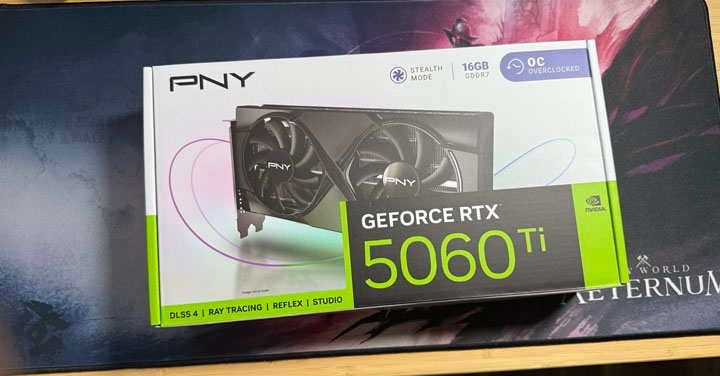PNY RTX 5060 Ti OC 16GB Review: 1440p Power?
Nvidia’s latest addition to its Blackwell GPU lineup, the RTX 5060 Ti, makes its debut with two variants: an 8GB and a 16GB model. Targeting the popular 1440p gaming resolution, this new graphics card aims to bring the cutting-edge advancements of the Blackwell architecture, including its AI-powered features, to a more accessible sub-$500 MSRP.

PNY RTX 5060 Ti OC 16GB Review: 1440p Power?
This review focuses on the PNY RTX 5060 Ti OC 16GB, evaluating its overall performance and value in today’s competitive GPU market.
PNY RTX 5060 Ti: Design, Specs, and Key Features
As Nvidia does not offer a Founders Edition for the RTX 5060 Ti, our review examines an AIB (Add-in-Board) model from PNY: the PNY RTX 5060 Ti OC 16GB. Despite being a factory-overclocked variant, this 16GB card is set to hit the market at Nvidia’s suggested retail price of $429. It’s important to note that this pricing does not factor in any potential impact from current US tariff policies, which could influence street prices.
Key Specifications at a Glance:
- Architecture: Blackwell
- CUDA Cores: 4608
- Tensor Cores (AI): 5th Generation (759 AI TOPS)
- Ray Tracing Cores: 4th Generation (72 TFLOPS)
- Boost Clock: 2.69 GHz (PNY OC model)
- Base Clock: 2.41 GHz
- Memory: 16 GB GDDR7 (128-bit interface, 448GB/s bandwidth)
- I/O: 3x DisplayPort 2.1b; 1x HDMI 2.1b
- Max GPU Temp: 87 degrees Celsius
- Total Graphics Power: 180 Watts
- Required PSU: 600 Watt
- Power Connector: 1x PCIe 8-pin
- MSRP: $429 (16 GB reviewed); $379 (8 GB variant)
The PNY RTX 5060 Ti OC 16GB is a compact, two-slot card featuring a dual-fan cooling design. Its relatively small footprint makes it an excellent choice for small form-factor (SFF) PC builds, offering powerful performance without demanding excessive case space. A crucial design decision for many upgraders is the retention of the standard 8-pin PCIe power connector, avoiding the newer 12VHPWR connectors seen on other 50-series cards. This simplifies the upgrade process and potentially alleviates concerns associated with the newer connector’s reliability.
Blackwell Architecture and Advanced Technologies
The RTX 5060 Ti leverages the full suite of technologies introduced with Nvidia’s Blackwell architecture, most notably significant advancements in Deep Learning Super Sampling (DLSS). This includes the robust Multi-frame generation feature, designed to boost frame rates significantly in supported titles.
Beyond current capabilities, Blackwell paves the way for future AI-powered rendering technologies like RTX Skin, Neural Shaders, and RTX Mega Geometry, promising even more realistic and efficient rendering.
Nvidia is launching both an 8GB and a 16GB version of the RTX 5060 Ti. While our review focuses on the more prevalent 16GB model, the difference in VRAM is a key consideration. The 16GB variant, priced at $429 MSRP ($50 more than the 8GB), is generally considered the more compelling option for 1440p gaming, especially for heavy ray tracing applications.
Experience with the previous generation’s RTX 4060 Ti 8GB demonstrated that 8GB of VRAM often proved insufficient, even with DLSS enabled. For gamers concerned about future-proofing their investment, the 16GB offers a stronger hedge against increasing VRAM demands of upcoming titles.
Test Methodology and Setup
To thoroughly evaluate the PNY RTX 5060 Ti OC 16GB, we subjected it to our standard suite of synthetic and gaming benchmarks, with a primary focus on 1440p performance. Our testing included both traditional rasterization and ray tracing scenarios.
Test Bench (Starforge Systems Voyager II):
- CPU: Intel Core i7-14700K
- CPU Cooler: Starforge Custom Bitspower 360mm Liquid Cooler
- RAM: Teamgroup Delta RGB 32GB DDR5 6000 CL38 (2x16GB)
- Motherboard: MSI Z790 Tomahawk Wifi DDR5
- Primary Storage: 2TB PCIe 4.0 NVMe SSD
- Power Supply: Corsair HX1200i 1200 Watt Platinum
The RTX 5060 Ti was benchmarked against other similarly targeted GPUs from both Nvidia and AMD:
- Nvidia: ASUS Prime RTX 5070 Ti, RTX 5070 Founders Edition, RTX 4070 Super Founders Edition, RTX 4060 Ti 8GB Founders Edition
- AMD: XFX SWIFT RX 9070 XT, XFX SWIFT RX 9070, Radeon RX 7800 XT Reference Model
For realistic performance assessment, ray tracing tests leveraged Nvidia’s DLSS and AMD’s FidelityFX Super Resolution (FSR) where applicable. Frame Generation was also enabled when possible, reflecting how most players would utilize these technologies. In-game benchmarks were used for consistency, and repeatable circuits were employed for titles without built-in tools. ReBAR and XMP profiles were enabled via the system’s BIOS.
Synthetic and Rasterized Gaming Benchmarks
In synthetic tests like Firestrike and TimeSpy, the RTX 5060 Ti generally lags behind all but the previous generation’s RTX 4060 Ti 8GB. For example, it shows a 34% improvement over the RTX 4060 Ti 8GB in Firestrike but trails AMD’s RX 7800 XT by 19%. In TimeSpy, the RTX 5060 Ti is beaten by the RTX 5070 FE by 26% and the RX 7800 XT by 14%.
However, in the Port Royal ray tracing benchmark, Nvidia’s architectural strength shines, with the RTX 5060 Ti narrowly edging out the RX 7800 XT by 1%, within the margin of error.
When it comes to real-world rasterized gaming at 1440p, the pattern largely holds. The RTX 5060 Ti consistently outperforms the RTX 4060 Ti 8GB, showing a significant 42% increase in performance in Cyberpunk 2077 and 41% in Black Myth Wukong. On average, the PNY RTX 5060 Ti OC 16GB delivered a 25% uplift compared to the RTX 4060 Ti 8GB.
Against AMD’s RX 7800 XT, also equipped with 16GB of VRAM, the RTX 5060 Ti fares less favorably in rasterization. The RX 7800 XT, on average, performed 11% better in our tests, with titles like Final Fantasy XIV: Dawntrail seeing an 18% lead for the AMD card.
Compared to its more expensive 50-series siblings, the RTX 5070 leads the RTX 5060 Ti by about 20%, despite costing 27% more. AMD’s new RDNA 4 RX 9070 XT and non-XT cards also outperform the RTX 5060 Ti by 31% and 28% on average, respectively.
Ray Tracing and DLSS 4 Performance
Nvidia’s strength in ray tracing becomes evident when these features are enabled. The 4th Generation RT Cores in the RTX 5060 Ti prove their worth, significantly outperforming the RTX 4060 Ti and the RX 7800 XT. On average, the RTX 5060 Ti OC 16GB is 35% faster than the RTX 4060 Ti 8GB (without Multi-frame generation) and 34% faster than the RX 7800 XT in our ray tracing tests.
However, a surprising outcome was its performance relative to the last-generation RTX 4070 Super FE, which was about 14% faster. Traditionally, new-generation cards in the same tier are expected to match or exceed the performance of the previous generation’s higher-tiered cards, which is not entirely the case here.
DLSS 4’s Multi-frame generation (MFG) allows the RTX 5060 Ti to punch above its weight class, particularly in demanding titles like Cyberpunk 2077, Marvel Rivals, Hogwarts Legacy, and Dragon Age: The Veilguard. While MFG can yield impressive frame rate gains (e.g., 89 FPS at 4K with full path tracing in Cyberpunk 2077), users must be mindful of input latency.
At very low native resolutions, MFG cannot fully compensate for high latency, leading to a less responsive experience. Optimal results with MFG are typically found at 1440p, where input latency is halved, making the experience much more playable. The RTX 5060 Ti handled Marvel Rivals well with MFG 4x, reaching 156 FPS on average, providing a smooth experience for casual players.
Thermals and Power Consumption
The RTX 5060 Ti is rated for a Total Graphics Power (TGP) of 180W. Our testing, using PCAT, confirmed that the card consistently stayed within this limit. In Cyberpunk 2077, the card drew 179 watts, indicating that even with PNY’s factory overclock, power draw remains within specifications. The PNY RTX 5060 Ti OC 16GB reached a peak clock speed of 2.8GHz during testing, exceeding its advertised 2.69GHz boost clock.
Thermally, the PNY model performed admirably. Thanks to its metal backplate and efficient flow-through design, the card hit a maximum temperature of 70 degrees Celsius during demanding tests like Dragon Age: The Veilguard, typically hovering around 67 degrees Celsius on average.
Conclusion and Value Proposition
The PNY RTX 5060 Ti OC 16GB delivers a respectable performance uplift over its predecessor, the RTX 4060 Ti 8GB, with an average 25% improvement in rasterization and 35% in ray tracing. This makes it a compelling upgrade for users holding onto much older Nvidia 60-class cards (e.g., GTX 1060 or RTX 2060), offering a night-and-day performance difference, especially with the benefits of DLSS.
However, the value proposition becomes more complex when considering other cards in its price range, including used last-generation GPUs from both Nvidia (like the RTX 4070 Super FE, which surprisingly outperformed the 5060 Ti in both raster and ray tracing) and AMD (such as the RX 7800 XT, which leads in raster performance). The RX 7800 XT outperformed the RTX 5060 Ti by 11% on average in rasterized benchmarks, though Nvidia maintained a strong 34% lead in ray tracing.
The current market conditions, plagued by inconsistent availability at MSRP and the ongoing impact of trade tariffs, further complicate the purchasing decision. While the RTX 5060 Ti OC 16GB provides an excellent 1440p gaming experience at max settings and leverages powerful Blackwell features like DLSS 4’s MFG for demanding titles, its higher price point (compared to the historical “budget” positioning of 60-class cards) puts it in competition with alternatives that might offer better value or even a full console for a similar cost.
Ultimately, if you are a dedicated PC gamer looking to upgrade from an older GPU and can find the PNY RTX 5060 Ti OC 16GB near its MSRP, it represents a solid choice for a future-proofed 1440p experience, particularly if you value Nvidia’s ray tracing and DLSS ecosystem. However, potential buyers are strongly encouraged to compare prices and performance across the market extensively before making a final decision.




